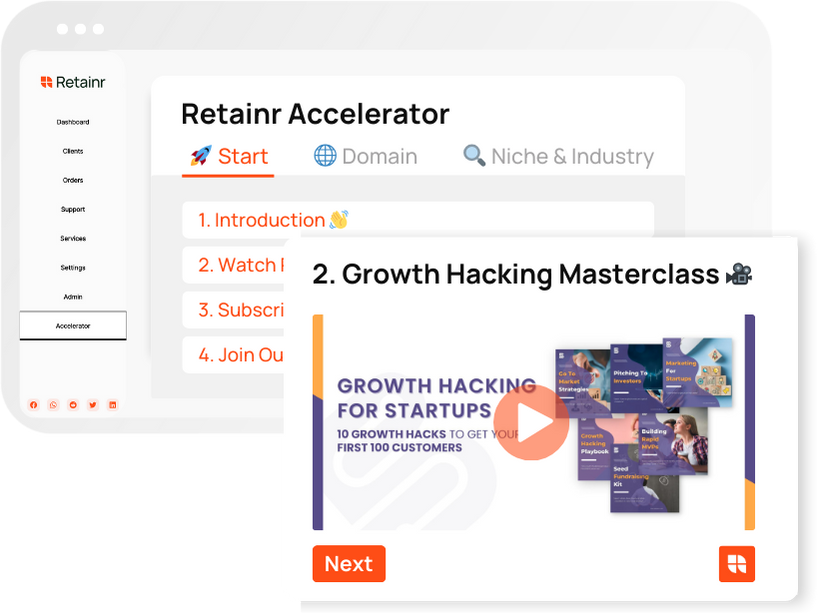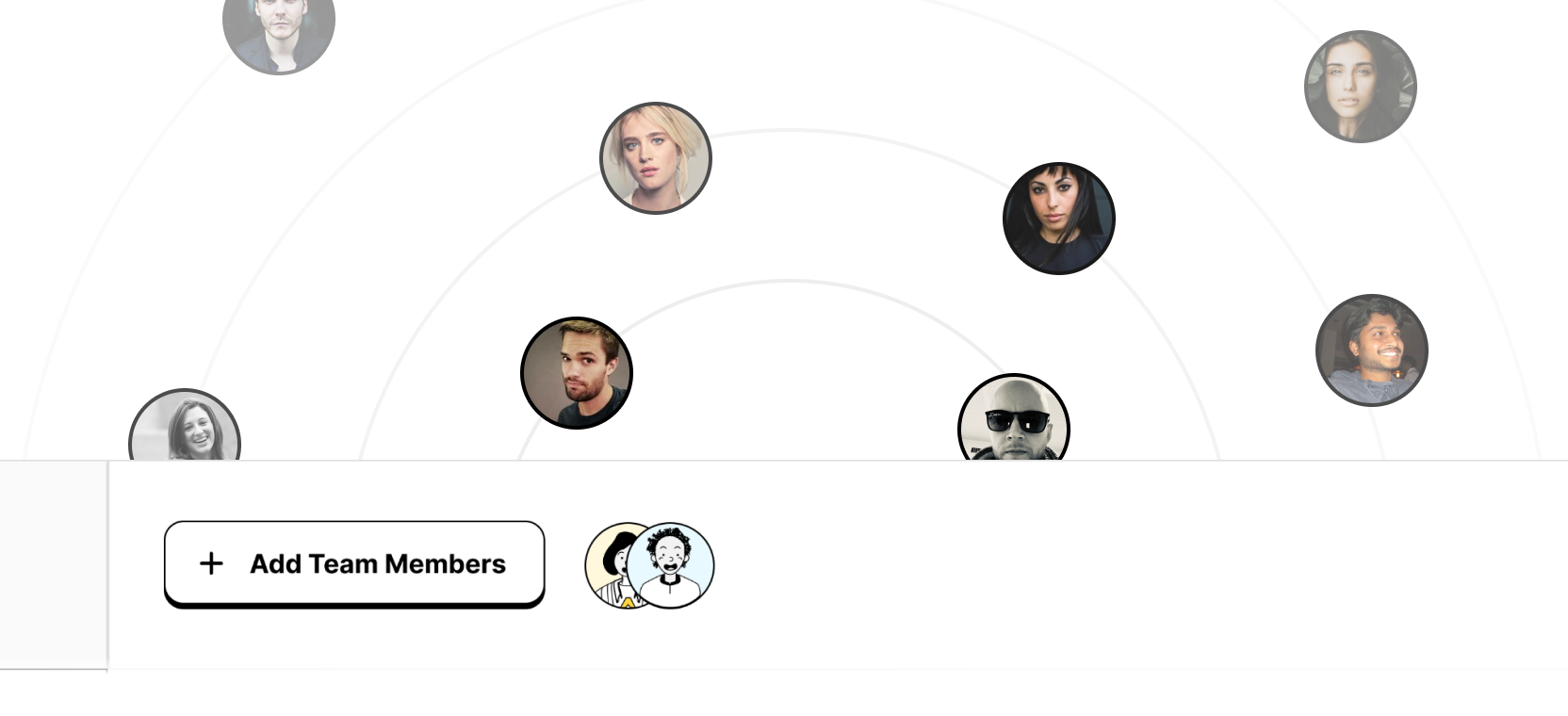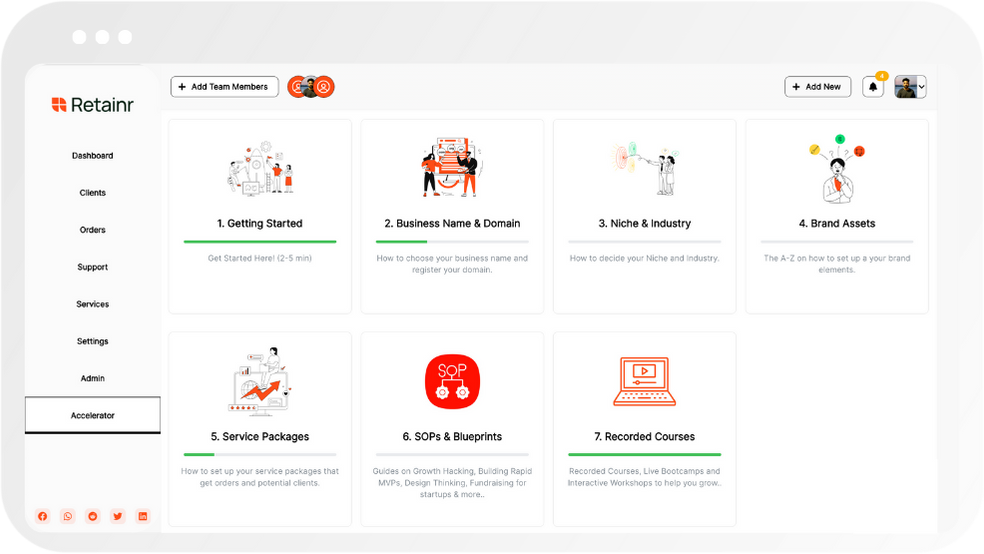
7 Tools for Customizing User Experience
Build with Retainr
Sell your products and services, manage clients, orders, payments, automate your client onboarding and management with your own branded web application.
Get Started1. What are the 7 tools for customizing user experience?
Tools for Customizing User Experience
Customizing user experience is essential for business growth and customer satisfaction. A tailor-made user experience caters to the unique needs of users and enhances their interaction with the business's website or application. Here are seven of the leading tools for creating unique user experiences:
- Google Analytics: This tool provides insights on user behavior and preferences, helping businesses understand how to cater to their audience.
- Hotjar: Hotjar helps visualize the user's journey on your website using heatmaps, session recordings, and surveys.
- Optimizely: Optimizely is a tool that allows for experimentation and personalization, enabling businesses to try out different user interfaces to see what works best.
- Hallway Testing: This is a user-testing process involving unscheduled checks for usability by anyone passing by, hence the name.
- Persona Creation: This tool involves creating fictional characters that represent your user base and designing for these personas.
- Sketch: Sketch is a digital design toolkit that can prototype a user interface for testing.
- UserTesting: UserTesting is a platform that offers real-time feedback from users testing your website or application.
Understanding the Tools and Their Functions
Now that we have identified the seven tools, let's delve deeper into their overall function, usage and how they contribute to enhancing user experience.
| Tool | Function | Usage |
|---|---|---|
| Google Analytics | Gives insights on user behavior | Reveals what users are most interested in on your website |
| Hotjar | Visualizes user's journey | Helps identify areas users interact with most or least |
| Optimizely | Allows for experimentation and personalization | Enables trying out different interfaces for optimum results |
| Hallway Testing | Allows for casual usability testing | Finds out how intuitive the interface is for random users |
| Persona Creation | Helps represent user base | Guides design to cater to certain identifiable groups |
| Sketch | Prototypes a user interface | Allows swift creation of design drafts and easy testing |
| UserTesting | Offers real-time feedback from users | Get insights and suggestions from actual users |
2. How do these tools help in enhancing the user experience?
Understanding User Experience Tools
These tools are designed to enhance the user experience by providing valuable insights, simplifying complex tasks, and allowing customization based on user's preferences. They are primarily focused on improving interaction between the user and the product or service, by making them more efficient, accessible, and enjoyable.
The Role of These Tools
- User Analytics: These tools record user interactions, provide insights into user behaviour, and identify areas that need improvements. It helps in understanding what users are looking for and adjust the interface accordingly.
- User Testing: These tools allow businesses to test their product with real users and get immediate feedback. This helps in making necessary adjustments to improve overall user satisfaction.
- Prototyping: These tools allow developers to create a simplified version of the product and experiment with different designs and functions. It helps in visualizing how the final product will look and function.
Thus, by using these tools, designers and developers can create a product that is more in line with user expectations, enhancing the overall user experience.
Examples of UX Tools and Their Benefits
| Tool | Benefits |
|---|---|
| Google Analytics | Helps to understand the user’s journey and the performance of the website. |
| UsabilityHub | Enables quick and easy user testing on design decisions. |
| InVision | Allows creating interactive and realistic prototypes quickly. |
These are just some examples of how UX tools can aid in improving the quality of the product and consequently enhance the user's experience.
3. Can you provide examples of using these tools in a real-world application?
Examples of Customizing User Experience Tools in Applications
One tool for customizing user experience is A/B Testing which includes software like Optimizely or Adobe Target. A real-world application of these tools can be seen in e-commerce websites like Amazon. They often use A/B testing to experiment with different site layouts, color schemes, or promotional incentives on a random selection of their website visitors. The site then collects data on the performance of each version to determine which one provides the best customer experience. It helps improve their conversion rate and sales by optimizing the checkout process, improving product display pages, and adjusting pricing strategies.
The second tool involves using Heat Mapping tools, such as Hotjar or Crazy Egg. These tools can capture where users are clicking on the page, how far they scroll, and what they're ignoring. For instance, a news site can use heat mapping tools to see which types of articles most attract their readers and where on the page users tend to lose interest. This valuable information can guide the website on how to arrange their content for maximum engagement.
| Tool | Real-World Application |
|---|---|
| A/B Testing | E-commerce websites like Amazon testing different add-to-cart buttons. |
| Heat Mapping | News sites measuring engagement on different article styles. |
Lastly, Personalization Platforms like Dynamic Yield or OneSpot are efficient tools for customizing user experience. Netflix is a perfect example of a brand that effectively uses a personalization tool. They provide a tailored catalog view based on each user's past viewing habits, ratings, and search history. This kind of personalized experience is not just delightful but encourages engagement and retention of users.
4. What are the advantages and disadvantages of using these tools?
Advantages of Using User Experience Customization Tools
Firstly, these user experience customization tools are lauded for their key benefits:
- Personalization: These tools can help provide a personalized experience to each user, enhancing customer satisfaction and engagement.
- Improved Conversion Rates: Personalized experiences can lead to higher conversion rates as the content resonates more with the user.
- Data Capture: Most of these tools help collect data about users, which can be utilized to further refine strategies and boost engagements.
- User Retention: Offering unique experiences to users boosts retention and encourages repeat visits.
Disadvantages of Using User Experience Customization Tools
Despite their significant advantages, there are a few drawbacks associated with these tools:
- Cost: Many sophisticated tools can be quite costly, especially for small business owners or startups without a significant budget.
- Complexity: They often require technical know-how to get the best results, which could entail hiring a dedicated team or specialist.
- Data Oversaturation: While gathering data can be beneficial, these tools can often collect an overwhelming amount of information, making it difficult to interpret or utilize effectively.
Comparative Overview
The following table provides a comparative overview of the advantages and disadvantages of using UX customization tools:
| Advantages | Disadvantages |
|---|---|
| Personalization | Cost |
| Improved Conversion Rates | Complexity |
| Data Capture | Data Oversaturation |
| User Retention | N/A |
5. How can these tools be integrated into my existing digital platform?
Integrating User Experience Tools into Existing Platforms
Integrating user experience (UX) tools into your existing digital platforms can be done seamlessly, mostly depending on the specific tool and platform. Here are some of the common steps you can follow to successfully incorporate these tools into your platform:
- Choose your tool: Before you can think about integration, you need to select the tools that will best serve your needs. Options may include analytics tools, survey tools, heat map tools, and more.
- Set up your account: Most UX tools require an account setup with a unique username or email and a secure password.
- Install the tool: This may involve downloading a software or adding a simple JavaScript snippet to your site. This depends on the specific tool.
- Test the tool: After installation, run the tool and ensure every feature is running correctly.
What's more, some platforms may also offer their own integration tutorials or guides with steps specific to their platform so be sure to take advantage of that. It's also crucial to remember that the integration process may vary based on the tool and the platform.
Integration Table Example
Here is an example of a simple table that outlines the process of integrating user experience tools into your platform:
| Step | Action |
|---|---|
| 1 | Choose your tool. |
| 2 | Set up your account. |
| 3 | Install the tool. |
| 4 | Test the tool. |
6. Can these tools be used for both web and mobile applications?
Compatibility of User Experience Tools
The customization tools designed to enhance user experience (UX) are highly versatile and show a high level of compatibility with both web and mobile applications. This adaptability to various platforms makes these tools extremely beneficial for developers to create unique, interactive, and dynamic user interfaces. These resources cater to the design preferences of developers and varying user needs, ensuring top-rated user experiences across multiple platforms.
List of Tools Compatible with Web and Mobile Applications
- Adobe XD: Offering seamless design and real-time prototyping, Adobe XD is available for both web and mobile app UX design.
- Sketch: Extremely popular among UX designers, sketch is optimized for web and app interfaces and allows for easy collaboration.
- Figma: This powerful design tool provides intuitive design components that are compatible with both web and mobile interfaces.
- Zeplin: Zeplin streamlines the handoff between designers and developers by turning your designs into specs and guidelines.
- InVision: Known for its high-fidelity prototyping, InVision is an effective tool to create web and mobile app mockups.
- Proto.io: This tool simplifies the procedure of creating interactive mobile and web app prototypes.
- Axure RP: Allows designers to create responsive prototypes with adaptive views for both web and mobile UX design.
Comparison Table of Web and Mobile App UX Tools
| Tool | Web UX Design | Mobile UX Design |
|---|---|---|
| Adobe XD | Yes | Yes |
| Sketch | Yes | Yes |
| Figma | Yes | Yes |
| Zeplin | Yes | Yes |
| InVision | Yes | Yes |
| Proto.io | Yes | Yes |
| Axure RP | Yes | Yes |
These tools not only show impeccable adaptability to web and mobile platforms, but they also bring efficiency and effectiveness to the design process. They serve as a bridge between developers and users, fostering interaction and feedback implementing necessary improvements to heighten the overall user experience.
7. Do I need technical skills to use these tools?
Understanding the Technical Skills for User Experience Tools
Often, professionals newly stepping into the User Experience (UX) field, or business owners looking to tweak their online platforms worry about the technical skills required to use UX tools. This may stem from the perception that complexities are involved, but generally, you do not need to be a tech whizz to effectively use these tools. Most of the UX tools available today are designed with user-friendly interfaces making them accessible to everyone, regardless of their technical prowess.
Non-technical UX Tools
Here is a list of some UX tools that do not require advanced technical skills:
- UserZoom: A combination tool that touches on UX design, surveys, and user testing.
- Optimal Workshop: A suite of tools used for card sorting, tree testing, and stakeholder management.
- Google Analytics: A commonly-used tool that tracks and reports website traffic, behavior, and more.
- SurveyMonkey: A tool for creating online surveys, polls, and quizzes.
- Hotjar: A tool that offers heat map generation and user session recordings.
- Figma: A design and prototype tool that drives collaboration among team members.
- Adobe XD: A vector-based user experience design tool for web apps and mobile applications.
Technical Skills and UX Design
While the above tools are easy to use, it's worth noting that having a basic understanding of certain technical areas can enhance your use of them. For a better understanding, let's draw a table:
| Technical Skill | Relevance |
|---|---|
| Coding (HTML/CSS) | Understanding of website structure and ability to make minor tweaks |
| Prototyping | Ability to create prototypes for testing and iterating the design |
| Understanding of Design Principles | To understand how elements work together to create a seamless user experience |
In conclusion, while technical skills are not a strict requirement for using UX tools, a basic understanding of certain areas can enhance their utilization. Therefore, a bit of learning in areas like coding, prototyping, and design principles would be beneficial. However, this is not a strict requirement as most of these tools are user-friendly and easy to understand.
8. What are the costs involved in acquiring and implementing these tools?
Acquisition and Implementation Costs
The expenses associated with acquiring and implementing tools for customizing user experience vary widely depending on the nature, complexity and the provider of the tool. It's crucial to understand these costs to come up with an informed budget. Generally, there are three primary categories of costs that businesses should anticipate:
- Purchase or Subscription Costs: This is the initial outlay businesses have to plan for. Many tools follow a monthly or annual subscription model, while others may charge a one-time fee.
- Implementation Costs: These include costs associated with setup, customization, and integration of the tools with existing systems. This may also include training costs for staff to learn how to use the new tools.
- Maintenance Costs: Long term costs like updates, ongoing support and potential upgrades could be an additional expenditure.
Example of Costs for Specific Tools
To give you a clearer picture, let's discuss the costs of four popular UX customization tools: Google Analytics, Hotjar, Optimizely and Adobe Experience Manager.
| Tool | Purchase/Subscription | Implementation | Maintenance |
|---|---|---|---|
| Google Analytics | Free / Premium starts at $150,000 annually | Dependent on staff training needs | Updates and support offered free of charge by Google |
| Hotjar | Basic (Free) to Business ($389/month) | Mostly user-driven, minimal training required for maximum effect | Updates and regular improvements included in subscription |
| Optimizely | Custom pricing based on business size and needs | Training and integration costs vary based on business needs | Subscription typically includes updates and support |
| Adobe Experience Manager | Estimate required from Adobe | Potentially significant implementation and training costs | Updates and support included in subscription fees |
Benefits Vs Costs
While these costs may seem high, it's important to weigh them against the potential benefits of improved user experience. A better UX can lead to higher customer engagement, improved conversions, increased customer loyalty and ultimately, a better bottom line. These benefits could well offset the costs, making the investment a real value-for-money proposition for businesses.
9. Are there training resources available for these tools?
Training Resources for User Experience Tools
For most of these User Experience (UX) tools, there are a variety of resources available for training and support. The resources range from online tutorials, official documentation provided by the software developers, and even online communities where you can interact with other users of the tools. Below is a list of resources for each of these tools:
- Sketch:offers a comprehensive learning guide that includes video tutorials, available on the Sketch website.
- InVision:provides a library of online tutorials. They also host webinars and Q&A sessions for their users and have an active community for support.
- Marvel:features a variety of resources including a blog with useful name articles and how-to guides. They also provide video tutorials and demos.
- Figma:offers a broad range of educational materials. These include online classes, video tutorials, and articles on the software’s best practices.
- Adobe XD :offers a series of user-friendly materials, such as online video tutorials, how-to guides, and blogs.
- Zeplin:has a user-friendly help center with a FAQ section and several how-to articles which provide insight into the tool’s features and usage.
- Balsamiq:provides start-up tutorials, online classes, and a whole section on their website dedicated to learning about wireframing.
Comparison of Training Resources
Here is a table that gives a quick comparison of the major types of training resources available for each tool, which will help you select the one that suits your training preferences best:
| Tool | Online Tutorials | Webinars | Community Support |
|---|---|---|---|
| Sketch | Yes | No | No |
| InVision | Yes | Yes | Yes |
| Marvel | Yes | No | No |
| Figma | Yes | No | Yes |
| Adobe XD | Yes | No | Yes |
| Zeplin | Yes | No | No |
| Balsamiq | Yes | No | No |
10. How do these tools contribute to business growth and customer satisfaction?
Contributions to Business Growth
Customizing user experience significantly enhances business growth by utilizing the following tools
- Personalization: Tools such as Optimizely or Google Optimize allow for A/B testing and tracking user behavior. This data-driven approach aids in creating personalized experiences, hence, boosting conversion rates.
- Interaction Design: Software like Adobe XD and Sketch assist in creating interactive designs. Better user interface and interaction design lead to improved user engagement, directly influencing sales and revenue.
- Live Chat Tools: Implementing platforms like Intercom and Drift help establish real-time communication with users. Prompt response increases customer retention and loyalty, impacting the growth positively.
- Analytics: Google Analytics or Mixpanel provide detailed insights about user actions on the website. These insights help in understanding user interests and adjust the website accordingly, which can improve the audience reach.
Enhancing Customer Satisfaction
The aforementioned tools also play an immense role in improving customer satisfaction.
| Tool | Role in Customer Satisfaction |
|---|---|
| Optimizely/Google Optimize | Deliver personalized content catering to individual user interests, improving user experience and satisfaction. |
| Adobe XD/Sketch | Ease in navigation and better interaction design creates a positive experience leading to higher customer satisfaction. |
| Intercom/Drift | Prompt customer support addressing user queries and concerns cumulates into higher customer satisfaction. |
| Google Analytics/Mixpanel | Understanding user behavior and making data-driven decisions to cater to the user demands results in improved customer satisfaction. |
Conclusion
In conclusion, these tools help improve user experience by offering personalized content, enabling better interactions, providing real-time support, and giving deep insights into user behavior. This not only enhances business growth by boosting conversions, sales and audience reach, but also improves customer satisfaction by crafting pleasant user experiences and promptly addressing their needs.
Conclusion
Transform User Experience with 7 Crucial Tools
The online space is vibrant, dynamic and constantly evolving, necessitating businesses to provide a seamless and bespoke user experience (UX) for their clients. We've curated a list of seven powerful tools that will help you to efficiently customize UX and escalate your business growth.
Retainr.io: The Ultimate Whitelabel Software
The first tool in our list is Retainr.io. This application allows businesses to sell, manage clients, orders, and payments effectively within their own branded application. With Retainr.io, businesses can distinguish their services, maintain consistent branding, and offer a personalized UX for their clients.
Key Features of Retainr.io
- Seamless eCommerce Integration: Retainr.io flawlessly integrates with your existing online store, allowing smooth and secure transactions.
- Easy Client Management: Maintain and manage your clients effortlessly with Retainr.io's user-friendly interface.
- Brand Enhancement: Elevate your brand image with your own branded app.
Other Tools for Customizing UX
While Retainr.io undoubtedly stands out for its whitelabel capabilities, there are other tools available to enhance different aspects of UX. From analytics and testing tools to CRM and marketing automation platforms, these tools facilitate valuable insights, allow for A/B testing, help build customer relationships, and automate marketing activities.
Conclusion
Delivering a personalized UX is no longer a luxury; it's a necessity. Stand out in the competitive online market with these seven tools, especially with Retainr.io, your ultimate whitelabel software solution.
Boost Your Agency Growth
with Retainr Accelerator
Uncover secrets, strategies, and exclusive blueprints to take your agency's growth to the next level — from marketing insights to effective presentations and leveraging technology.

SOPs, Cheatsheets & Blueprints
Leverage 50+ SOPs (valued over $10K) offering practical guides, scripts, tools, hacks, templates, and cheat sheets to fast-track your startup's growth.
Connect with fellow entrepreneurs, share experiences, and get expert insights within our exclusive Facebook community.
.jpg)

Join a thriving community of growth hackers. Network, collaborate, and learn from like-minded entrepreneurs on a lifelong journey to success.

Gain expertise with recorded Courses, Live Bootcamps and interactive Workshops on topics like growth hacking, copywriting, no-code funnel building, performance marketing and more, taught by seasoned coaches & industry experts.

.jpg)

.jpeg)


